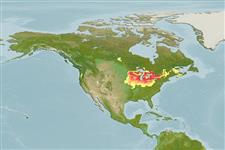Classification / Names
Common names | Synonyms | Catalog of Fishes (gen., sp.) | ITIS | CoL | WoRMS | Cloffa
Actinopterygii (ray-finned fishes) >
Esociformes (Pikes and mudminnows) >
Umbridae (Mudminnows)
Etymology: Umbra: Latin, umbra, -ae = shadow, in the sense of phantom; due to its quick movements (Ref. 45335); limi: limi meaning of the mud (Ref. 10294).
Environment / Climate / Range
Ecology
Freshwater; demersal; pH range: 6.0 - 6.5; dH range: 3 - 8. Temperate; 17°C - 22°C (Ref. 1672), preferred ?; 52°N - 36°N
North America: St. Lawrence-Great Lakes, Hudson Bay (Red River) and Mississippi River basins from Quebec to Manitoba in Canada and south to Ohio, Tennessee and Arkansas, USA; Hudson River drainage (Atlantic Slope) in New York, USA. Isolated populations in Missouri River drainage of South Dakota and Iowa, USA.
Size / Weight / Age
Maturity: Lm ? range ? - ? cm
Max length : 14.0 cm TL male/unsexed; (Ref. 5723); common length : 8.2 cm TL male/unsexed; (Ref. 12193); max. reported age: 4 years (Ref. 12193)
Occurs in quiet areas of streams, sloughs, swamps and other wetlands over mud and debris (Ref. 5723, 10294). Often found in dense vegetation. Tolerates drought, low oxygen levels and extremes water temperature (Ref. 5723). Feeds on aquatic insects, amphipods, isopods, and snails (Ref. 10294).
Life cycle and mating behavior
Maturity | Reproduction | Spawning | Eggs | Fecundity | Larvae
Page, L.M. and B.M. Burr, 1991. A field guide to freshwater fishes of North America north of Mexico. Houghton Mifflin Company, Boston. 432 p. (Ref. 5723)
IUCN Red List Status (Ref. 115185)
CITES (Ref. 94142)
Not Evaluated
Threat to humans
Harmless
Human uses
Aquarium: commercial
Tools
Special reports
Download XML
Internet sources
